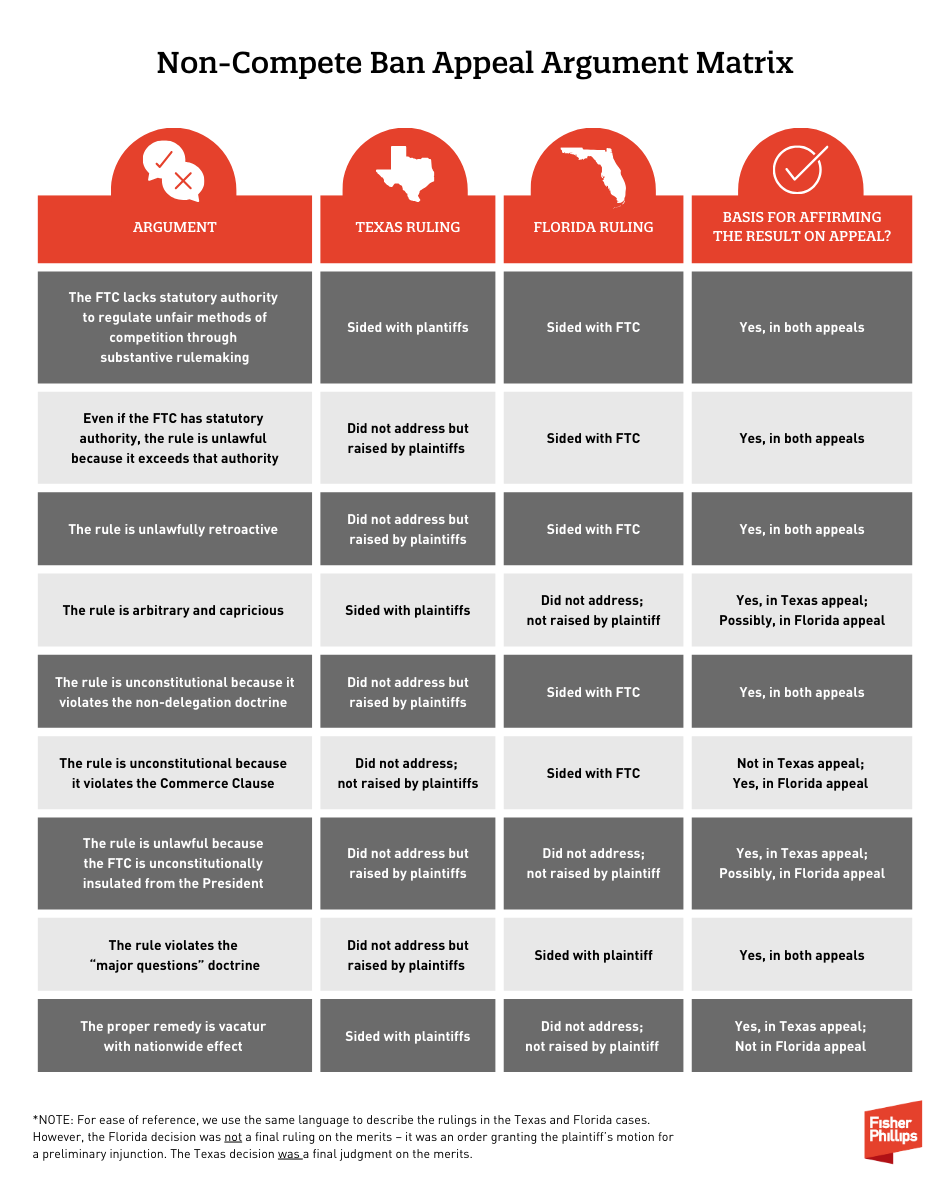Breaking Down the FTC Non-Compete Ban Appeals: Heading to a Circuit Split and SCOTUS Intervention?
Insights
10.22.24
The Federal Trade Commission has appealed two federal trial court decisions – one in Texas and one in Florida – that prevented the agency from enforcing its near-total ban on non-compete agreements. The Texas appeal, filed on October 18, seeks to reverse a decision that completely set aside the ban for all employers across the nation. The Florida appeal, which was lodged back in late September, seeks to overturn a preliminary ruling that prevented the FTC from enforcing the ban against a single employer. These decisions are now heading up to the 5th and 11th Circuit Courts of Appeal, respectively. What do you need to know about these appeals and the likelihood of an eventual trip to the Supreme Court – and what you should do in the meantime?
Primer on FTC Non-Compete Ban and Court Rulings
For a quick reminder on the scope of the ban and the details of the underlying rulings, read more below:
- Feds Ban Non-Compete Agreements: A 5-Step Plan for Employers (April 24)
- Frequently Asked Questions About the FTC’s Rule Banning Non-Compete Agreements (May 16)
- Florida Court is Next to Rule Against FTC’s Non-Compete Ban, But Employers Not Yet in the Clear (August 15)
- BREAKING NEWS: FTC’s Non-Compete Ban Struck Down for All Employers Nationwide (August 21)
Why Did the Lower Courts Rule Against the FTC?
Two different judges in Texas and Florida both ruled that the FTC could not enforce its non-compete ban, but they reached that result for different reasons.
- The Texas court held the FTC lacked the statutory authority to issue the ban, ruling that the agency generally does not have the power to issue substantive rules regulating unfair methods of competition. The FTC, as an administrative agency, can only do the things that Congress authorizes it to do through a statute, and the court concluded that it took things a few steps too far. But even if the FTC had that authority, the Texas court further held the ban was unlawful because it was “arbitrary and capricious.” The court was not impressed with what it called the agency’s unreasonably broad “one-size-fits-all” approach that did not target specific, harmful non-competes, and concluded the FTC failed to sufficiently address less drastic alternatives.
- The Florida court, on the other hand, sided with the FTC on nearly all its arguments. Unlike the Texas judge, the Florida judge concluded that the FTC has the statutory authority to issue substantive rules regulating unfair methods of competition. But the Florida judge prevented the FTC from enforcing the ban based on an issue the Texas judge did not reach – the “major questions” doctrine. Under this principle, the FTC had to show it had “clear congressional authorization” to issue the ban since the FTC’s rule was of “extraordinary” economic and political significance. The court held the FTC failed to make that showing.
What Must the FTC Prove to Win on Appeal?
The FTC faces a difficult path to victory on appeal. Federal appellate courts, including the 5th and 11th Circuits, apply the “right for any reason” doctrine. This means they can affirm the result reached in the lower court for any reason supported by the law and the record, even if that argument was rejected in the lower court.
From a practical perspective, this means that the FTC will likely have to win on every argument raised by the challengers, not just the ones that formed the basis of the underlying rulings. Because the plaintiffs in both cases attacked the ban from several angles, the FTC will have its work cut out for it on appeal.
Here is an overview of the arguments raised below, and whether they can support an affirmance on appeal:
 What Should Employers Do Next?
What Should Employers Do Next?
The FTC’s appeals do not immediately change the current landscape for employers. The Texas district court judgment setting aside the FTC’s ban will remain in effect nationwide during the pendency of the 5th Circuit appeal.
The 5th Circuit’s practitioner’s guide states that the median time from filing a notice of appeal to issuance of the court’s opinion is 7.8 months, so that is a fair estimate for how long the appeal may be pending. You can expect a similar timetable for the 11th Circuit decision, so it would not be surprising to not see decisions until the middle of 2025.
There is a possibility that the 5th and 11th Circuits reach different conclusions on the various legal challenges to the ban. If a circuit split does result, the next stop would be the Supreme Court. Ultimately, the appeals process over the ban’s legality may take years to fully resolve, as any SCOTUS decision would likely not occur until 2026.
For now, employers across the country can continue to maintain non-competes as their state laws allow. But you should also be aware of the National Labor Relations Board’s continued focus on non-compete agreements and other covenants, like “stay-or-pay” provisions. Read more about these new developments here:
Many Non-Compete Agreements Violate Federal Law According to NLRB’s Chief Prosecutor: Your Top 7 Questions Answered (June 1, 2023)
NLRB Counsel Cracks Down On “Stay-or-Pay” Provisions and Non-Competes: 7 Steps Employers Should Consider in Response (October 8, 2024)
Conclusion
We will be monitoring the situation and providing updates as the court battles continue. Make sure you are subscribed to Fisher Phillips’ Insight System to gather the most up-to-date information directly to your inbox. Check out Blue Pencil Box for our daily updates on restrictive covenant law. If you have questions, please contact the authors of this Insight, your Fisher Phillips attorney, or any attorney in our Employee Defection and Trade Secrets Practice Group.
Related People
-
- Jonathan Crook
- Partner
